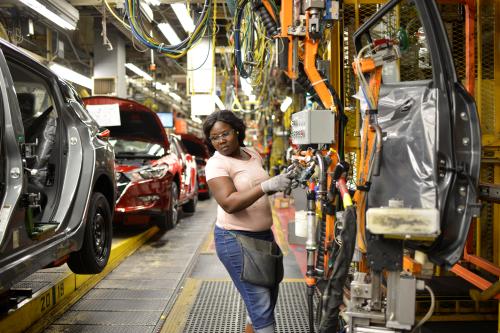This article was originally published by Jobs for the Future on March 12, 2020.
Inequality is a hot political topic. Donald Trump boasted in his State of the Union that he had created a “blue collar boom,” pointing to evidence that wages are rising fastest on the bottom rungs of the labor market. The Democrats competing to face the president in November are highlighting the gap between rich and poor. Bernie Sanders regularly attacks the influence of the “billionaire class.” Elizabeth Warren says that “wealth trickles up” in a “rigged system.” Joe Biden says “the middle class is getting killed.”
Two types of inequality dominate the debate. Type 1 is about income (or wealth) gaps at a particular point in time. When someone talks about the “gap between rich and poor,” they are typically referring to one of these measures.
Type 2 inequality spans across generations. In recent years, the work of Raj Chetty and his team at Opportunity Insights has shown how the economic position of parents influences outcomes for their children many decades later. In particular, their work has shown the role of postsecondary education in amplifying rather than reducing inequalities; the importance of neighborhoods in shaping opportunities; and the huge barriers to upward mobility faced by black men.
But there is a neglected aspect of inequality, lying between and influencing these two—the different trajectories of individuals across the course of their own working life. This intragenerational mobility is hugely important, economically and socially. There are big wage gaps in any given year, but much bigger ones over the course of many years. By looking at lifetime earnings inequality, we can get a better picture of the economic resources of working families over a broader span of time, and of how far the labor market has to go to offer real opportunities for workers to move up in terms of earnings.
It is one thing to be in a relatively low-paid job at the age of 26; quite another to still be in the same job, or earning about the same amount, two decades later. The work of scholars who have dug into this question provide three important insights:
1. Labor market ladders are getting narrower at the top
The chances of rising up the earnings ladder after embarking on your working life appear to be declining, according to work by Michael D. Carr and Emily E. Wiemers for the Washington Center for Equitable Growth. They examined the wage trajectories of workers over a 15-year period, starting at the age of 30, for different cohorts. Workers who are near the middle of the earnings distribution (40th to 70th percentile) at the age of 30 are now 20 percent less likely to make it into the top wage bracket (top 20 percent). In other words, there is less mobility.
It looks as if one big reason for this is that people with higher levels of education are moving into the top quintile before they hit 30 and staying there. In this sense, we have not just a “winner takes all” labor market, but a “winner takes early” one.
2. More education: Important but no guarantee of later success
The solution, then, would seem simple: more education. And there is clear evidence that overall, starting your working life with more credentials predicts higher earnings. But formal, pre-workforce learning is not a magic bullet. It turns out, for example, that on average a college degree is worth less to those from poorer backgrounds—compared, that is, to those from non-poor families. Research first published with the Brookings Institution, shows that the lifetime earnings of bachelor’s-degree holders from low-income families are significantly lower than for those from better-off homes.
3. There are chutes, too: Huge gender gaps in earnings profiles
So, class matters. But so too does gender. The average earnings trajectories of men and women look broadly similar until about the age of 30, but radically differ from about that point onward. “The period of age 35 to 44 is one when, in general, wages show the greatest lifetime gains,” says Michelle Budig in a paper prepared for the think tank Third Way. “It is also the same period when intensive family responsibilities, particularly for mothers, are in full force.”
As Budig reports, among full-time workers, women aged 25 to 34 years earn over 90 cents on a man’s dollar, but this gap widens precipitously, among those aged 35 to 44—to 78 cents—and never recovers for any older age group. There is a stark “motherhood” penalty, a chute so to speak, not just in terms of immediate lost earnings, but in terms of lost earnings progression.
More ladders, please
The challenge of creating more economic opportunity does not end at the school or college gates, but extends into the world of work. Historically, the labor market has offered greater opportunities for those with less education but who can “work their way up.” As the human capital accumulated in the first 25 years of life becomes more important in predicting lifetime earnings, the harder it gets to break intergenerational cycles of inequality. We need to build more ladders for everyone.






Commentary
Three factors hindering economic mobility in the workplace
March 12, 2020